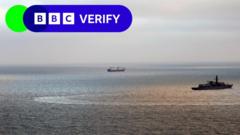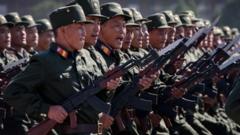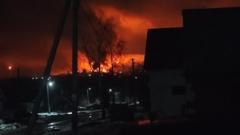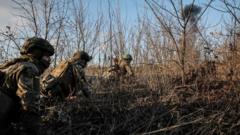Significant military equipment withdrawals from Tartous oceanfront mark a potential shift in Russia's involvement in Syria, aligning with recent political changes.
Russia's Military Withdrawal Accelerates in Syria's Tartous Port

Russia's Military Withdrawal Accelerates in Syria's Tartous Port
Increasingly visible troop movements signal potential end of Russian presence in the region.
As the situation in Syria evolves post-Assad regime, new developments indicate a substantial withdrawal of Russian military assets from the crucial Tartous port, a strategic base for Moscow. Recent analysis from BBC Verify highlights that the Kremlin has indeed escalated the extraction of vehicles and supplies, with satellite imagery confirming the diminishing presence of military hardware.
Following the regime change in December, footage captured convoys of Russian military vehicles relocating northward toward Tartous. The port has served as a critical support hub, enabling Russian naval operations in the Mediterranean. With the Assad regime's fall, however, concerns have arisen regarding the future of this military foothold, compounded by reports from Reuters about "frank discussions" between Russian officials and the newly installed Syrian government.
While there are unverified claims that the new Syrian administration has canceled Russia's operational lease at Tartous, government representatives have remained tight-lipped about any definitive decisions. Nevertheless, with historical significance as a logistical base, Tartous's future appears precarious without assured access for Russian forces.
Contentions surrounding the port's control hinge upon Moscow's desire to maintain its strategic presence amid shifting dynamics. Yet, indicators of withdrawal abound, with recent reports of military supplies being removed not just from Tartous, but from the Hmeimim airbase, suggesting an organized scaling back of military commitments in the region.
On January 21 and 22, two Russian vessels, Sparta and Sparta II—linked to the Russian ministry of defense—docked at Tartous. Both ships are under U.S. sanctions and have been associated with military transport activities. As of the latest tracking data, Sparta II had left the port by Monday, with satellite images revealing emptied access points where vehicles were previously stationed.
Resurfacing concerns about the secrecy of these operations arise, as signals from the ships' tracking devices were temporarily lost, potentially indicating concealed maneuvers. Global maritime analyst Frederik Van Lokeren emphasized speculation surrounding the vessels’ destinations, with possibilities of either returning to Russia or transferring equipment to Libya, where Russia has already indicated a military stake.
Furthermore, intelligence reports have surfaced regarding Russian aerial transport of military personnel from the Hmeimim base in Syria to Libyan airfields, signaling an ongoing and evolving strategy. Experts suggest that the end of a significant Russian military footprint at Tartous is foreseeable and imminent. Dmitry Gorenburg, a noted security specialist, remarked, “It's just a question of time until Russia's military presence at the base is concluded.”
The developments in Syria hold potentially broad implications for regional stability and Russia's strategic maneuvering in the Middle East and North Africa. As the international community continues to monitor these shifts, the future of Russian military operations remains tenuous.
Following the regime change in December, footage captured convoys of Russian military vehicles relocating northward toward Tartous. The port has served as a critical support hub, enabling Russian naval operations in the Mediterranean. With the Assad regime's fall, however, concerns have arisen regarding the future of this military foothold, compounded by reports from Reuters about "frank discussions" between Russian officials and the newly installed Syrian government.
While there are unverified claims that the new Syrian administration has canceled Russia's operational lease at Tartous, government representatives have remained tight-lipped about any definitive decisions. Nevertheless, with historical significance as a logistical base, Tartous's future appears precarious without assured access for Russian forces.
Contentions surrounding the port's control hinge upon Moscow's desire to maintain its strategic presence amid shifting dynamics. Yet, indicators of withdrawal abound, with recent reports of military supplies being removed not just from Tartous, but from the Hmeimim airbase, suggesting an organized scaling back of military commitments in the region.
On January 21 and 22, two Russian vessels, Sparta and Sparta II—linked to the Russian ministry of defense—docked at Tartous. Both ships are under U.S. sanctions and have been associated with military transport activities. As of the latest tracking data, Sparta II had left the port by Monday, with satellite images revealing emptied access points where vehicles were previously stationed.
Resurfacing concerns about the secrecy of these operations arise, as signals from the ships' tracking devices were temporarily lost, potentially indicating concealed maneuvers. Global maritime analyst Frederik Van Lokeren emphasized speculation surrounding the vessels’ destinations, with possibilities of either returning to Russia or transferring equipment to Libya, where Russia has already indicated a military stake.
Furthermore, intelligence reports have surfaced regarding Russian aerial transport of military personnel from the Hmeimim base in Syria to Libyan airfields, signaling an ongoing and evolving strategy. Experts suggest that the end of a significant Russian military footprint at Tartous is foreseeable and imminent. Dmitry Gorenburg, a noted security specialist, remarked, “It's just a question of time until Russia's military presence at the base is concluded.”
The developments in Syria hold potentially broad implications for regional stability and Russia's strategic maneuvering in the Middle East and North Africa. As the international community continues to monitor these shifts, the future of Russian military operations remains tenuous.




















